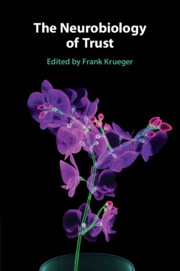Book contents
- The Neurobiology of Trust
- The Neurobiology of Trust
- Copyright page
- Dedication
- Contents
- Figures
- Tables
- Contributors
- Abbreviations
- Introduction
- Part I Fundamental Level of Trust
- Part II Neuropsychological Level of Trust
- Part III Neurocharacteristic Level of Trust
- Part IV Neuromolecular Level of Trust
- Chapter 13 Trust and Oxytocin
- Chapter 14 Trust and Psychopharmaca:
- Chapter 15 Trust and Genetics
- Part V Neuropathological Level of Trust
- Index
- References
Chapter 14 - Trust and Psychopharmaca:
Neuromodulation of the Signaling Pathways Underlying Trust Behavior
from Part IV - Neuromolecular Level of Trust
Published online by Cambridge University Press: 09 December 2021
- The Neurobiology of Trust
- The Neurobiology of Trust
- Copyright page
- Dedication
- Contents
- Figures
- Tables
- Contributors
- Abbreviations
- Introduction
- Part I Fundamental Level of Trust
- Part II Neuropsychological Level of Trust
- Part III Neurocharacteristic Level of Trust
- Part IV Neuromolecular Level of Trust
- Chapter 13 Trust and Oxytocin
- Chapter 14 Trust and Psychopharmaca:
- Chapter 15 Trust and Genetics
- Part V Neuropathological Level of Trust
- Index
- References
Summary
Psychopharmacological drug manipulation creates causal mechanisms for selectively stimulating or blocking target neurotransmitter receptors known to modulate brain regions engaged in trust behavior. In this chapter, we review studies that used pharmacological agents to act as neuromodulators in the neural signaling pathway mechanisms underlying trust behavior. First, we describe the laboratory measurements of trust behavior, the underlying domain-general large-scale brain networks, and its related target neurotransmitter systems that probe trust behavior. Second, we review the psychopharmacological studies focusing first on studies that implemented the trust game and second on studies that applied trust ratings after cooperative exchange games. Overall, some preliminary evidence exists that neuromodulators such as opiates, monoamine neurotransmitters (e.g., serotonin, dopamine), and pharmacologic agents such as 3,4-Methyl-enedioxy-methamphetamine increase monoamine neurotransmitter activity and impact trust behavior via experimental paradigms that have face validity in laboratory measures of trust. Finally, we indicate shortcomings in the present psychopharmacological research approach and offer guidance for future interdisciplinary research on the neuropsychoeconomic underpinnings of trust –shedding light on trust impairment as a key feature of several neuropsychiatric disorders.
Keywords
- Type
- Chapter
- Information
- The Neurobiology of Trust , pp. 338 - 368Publisher: Cambridge University PressPrint publication year: 2021



